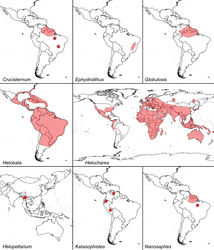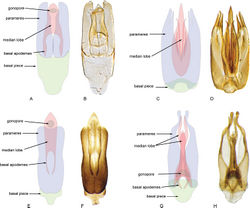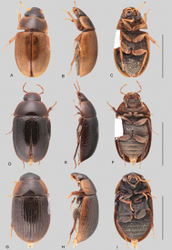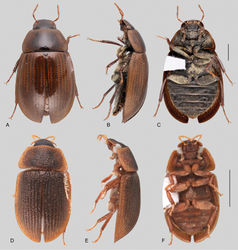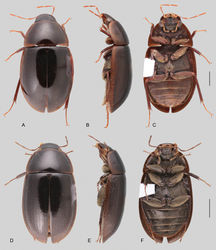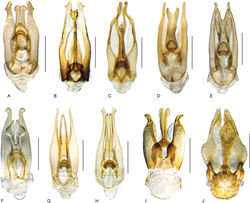Helochares
| Notice: | This page is derived from the original publication listed below, whose author(s) should always be credited. Further contributors may edit and improve the content of this page and, consequently, need to be credited as well (see page history). Any assessment of factual correctness requires a careful review of the original article as well as of subsequent contributions.
If you are uncertain whether your planned contribution is correct or not, we suggest that you use the associated discussion page instead of editing the page directly. This page should be cited as follows (rationale):
Citation formats to copy and paste
BibTeX: @article{Girón2021ZooKeys1045, RIS/ Endnote: TY - JOUR Wikipedia/ Citizendium: <ref name="Girón2021ZooKeys1045">{{Citation See also the citation download page at the journal. |
Ordo: Coleoptera
Familia: Hydrophilidae
Name
Helochares Mulsant, 1844 – Wikispecies link – Pensoft Profile
- Helophilus Mulsant, 1844a: 132 [rejected name no. 1707 (ICZN 1964, Opinion 710)].
- Helochares Mulsant, 1844a: 197; replacement name for Helophilus Mulsant, 1844a: 132; official name no. 1601 (ICZN 1964, Opinion 710).
- Enhydrus Dahl 1823: 34 [nomen nudum; rejected name no. 1705 (ICZN 1964, Opinion 710)].
- Enhydrus MacLeay, 1825: 35 [rejected name no. 1704 (ICZN 1964, Opinion 710)].
- Pylophilus Motschulsky, 1845: 32.
- [[ | ]] Type species: Hydrophilus griseus Fabricius, 1787: 189; fixed by monotypy = Dytiscus lividus Forster, 1771.
- Peloxenus Motschulsky, 1845: 549; replacement name for Pylophilus Motschulsky, 1845.
- Helophygas Motschulsky, 1853: 11 [rejected name no. 1708 (ICZN 1964, Opinion 710)].
- Helocharis Thomson, 1859: 18 [incorrect subsequent spelling].
- Hydrobaticus MacLeay, 1871: 131, syn. nov.
- [[ | ]] Type species: Hydrobaticus tristis MacLeay, 1871: 131; by subsequent designation by d’Orchymont (1943a[1]: 2); originally described as genus; downgraded to subgenus of Helochares by d’Orchymont (1919c[2]: 148).
- Helocharimorphus Kuwert, 1890: 306, syn. nov.
- [[ | ]] Type species: Helocharimorphus sharpi Kuwert, 1890: 307; by monotypy; originally described as genus; downgraded to subgenus of Helochares by d’Orchymont (1919c[2]: 148).
- Graphelochares Kuwert, 1890: 38.
- [[ | ]] Type species: Helophilus melanophthalmus Mulsant, 1844a: 137; by monotypy.
- Grapidelochares Ganglbauer, 1904: 248; [unjustified emendation of Graphelochares Kuwert, 1890].
Gender
Masculine.
Type species
Dytiscus lividus Forster, 1771: 52; by subsequent designation (Thomson 1859[3]: 18).
Diagnosis
Small to medium sized beetles, body length 2–7 mm. Body shape oval in dorsal view; slightly to moderately convex in lateral view, with dorsal outline nearly flat along anterior half of elytra, or somewhat evenly curved (Figs 35, 36). Coloration usually yellowish brown, sometimes orange brown, pale brown to medium brown; ground punctation shallow (e.g., Fig. 35D) to strongly marked (e.g., Fig. 36D). Shape of head trapezoid to oval (e.g., Fig. 11F). Eyes medium sized to large, not or moderately emarginated anteriorly, usually projected from outline of head. Clypeus trapezoid, with anterior margin broadly and roundly emarginate; sometimes lateral margins of clypeus slightly bent upwards. Labrum fully exposed. Mentum rather flat, sparsely punctate, coarsely to shallowly, rarely striate (e.g., Figs 35C, 36C); median anterior depression of mentum relatively shallow; submentum shallowly punctate to smooth. Antennae with nine antennomeres; cupule strongly asymmetric, with rounded outline; antennomere 9 slightly, to 3 × longer than antennomere 7. Maxillary palps slender, moderately long, 0.6–1.2 × the width of head (e.g., Figs 35C, 36C); inner margin of maxillary palpomere 2 weakly and evenly curved to nearly straight, outer margin evenly curved to curved along apical 2/3; maxillary palpomere 3 slightly longer than 4. Prosternum flat to medially bulging to tectiform. Elytra without sutural striae, with ground punctures usually moderately marked; often with serial punctures forming ten longitudinal rows along elytra (e.g., Fig. 35A). Posterior elevation of mesoventrite, flat to simply bulging (e.g., Fig. 35C); bulge usually with long fine setae; anapleural sutures strongly concave, nearly parallel along anterior section, separated anteriorly by distance 0.6–1.0 × anterior margin of mesepisternum. Metaventrite densely covered by hydrofuge pubescence, without glabrous patches (e.g., Figs 35C, 36C). Protibiae with spines of anterior row either nearly absent (e.g., Fig. 35C) or as long thick semi-erect setae. Metafemora with tibial grooves weakly developed to absent; hydrofuge pubescence covering basal 6/7 of anterior surface. Tarsomeres 1–4 with pair of lateral rows of long fine spines on ventral face, sometimes ventral face densely covered by hair-like spines; tarsomere 5 with medial row of long fine spines; metatarsomeres variable in proportions (2–4 gradually decreasing in size with 5 nearly as long as 3 and 4 combined; 2 and 5 similar in length, each slightly longer than 3 and 4 combined). Fifth abdominal ventrite apically emarginate, with fringe of stout setae. Aedeagus tubular (Fig. 37A–H); parameres fused to each other for most of their lengths, with apex either simple or bifurcate/bilobate; median lobe with very long basal apodemes (as long or longer than main piece of median lobe), often extending beyond base of parameres in repose; median lobe either simple (without subdivisions), or with multiple and different kinds of sclerotizations of inner membranes; basal piece usually much shorter than parameres; gonopore of variable development, usually visible when median lobe is simple.
Differential diagnosis
In the present definition, most species of Helochares are yellowish to brown in coloration, ranging in size from 2–7 mm (e.g., Figs 35, 36), usually moderately punctate throughout the dorsal surface, and most diverse in the Old World. Smaller members of the genus may be confused with Agraphydrus, from which Helochares can be distinguished by its uniformly pubescent metaventrite (e.g., 36C, F; Agraphydrus bears a distinct posteromedian glabrous patch on the metaventrite, e.g., Fig. 18F, I). From Peltochares, and Novochares, members of Helochares can be distinguished by their shorter and relatively stout maxillary palps [0.6–1.2 × the width of the head in Helochares (e.g., Fig. 35C), as opposed to slender, 1.3–1.8 × in Peltochares (e.g., Fig. 44C, F), 1.1–1.5 × in Novochares (e.g., Fig. 42C, F)]; and by the development of the tibial grooves (weakly developed to absent in Helochares, well developed in both Novochares and Peltochares). The most problematic species would be those that are dark brown, relatively flattened, highly polished, and 4–5 mm long. In those cases, the most reliable feature for identification would be the male genitalia: Helochares has tubular aedeagi (e.g., Figs 16E, F, 37A–H), Peltochares has spiked aedeagi (e.g., Figs 16C, D, 45), and Novochares has divided aedeagi (e.g., Figs 16G, H, 43); see explanation of aedeagal types under the aedeagus section of Morphological variation in Acidocerinae and its taxonomic importance).
Distribution
Afrotropical: Angola, Benin, Botswana, Burkina Faso, Burundi, Cameroon, Chad, Democratic Republic of the Congo, Eritrea, Ethiopia, Gabon, Gambia, Ghana, Guinea, Guinea Bissau, Ivory Coast, Kenya, Liberia, Madagascar, Malawi, Mali, Mauritania, Mauritius (incl. Mascarene Is., Rodrigues), Morocco [in doubt], Mozambique, Namibia, Niger, Nigeria, Oman, Republic of the Congo, Réunion, Rwanda, São Tomé and Príncipe, Saudi Arabia, Senegal, Seychelles (incl. Aldabra), Sierra Leone, Republic of South Africa, South Sudan, Sudan, Tanzania, Togo, Uganda, United Arab Emirates, Yemen (incl. Socotra), Zambia, Zimbabwe. Australasian: Australia (Australian Capital Territory, New South Wales, Northern Territory, Queensland, South Australia, Tasmania, Victoria, Western Australia), Fiji, Papua New Guinea (incl. Duke of York), Vanuatu. Indo-Malayan: Bangladesh, Burma, Cambodia, China (Fujian, Guangdong, Guangxi, Guizhou, Hainan, Hong Kong, Hunan, Jiangxi, Macao, Taiwan, Yunnan, Zhejiang), India (Andaman Is., Assam, Bihar, Karnataka, Madhya Pradesh, Nicobar Is., Uttarakhand, Uttar Pradesh, Tamil Nadu, West Bengal), Indonesia (Bali, Borneo, Java, Lombok, Papua, Sumatra), Laos, Malaysia (Peninsula, Sabah), Nepal, Philippines (Manila), Singapore, Sri Lanka, Thailand, Vietnam. Nearctic: U.S.A. (Alabama, Arkansas, Arizona, California, Delaware, District of Columbia, Florida, Georgia, Illinois, Indiana, Iowa, Kansas, Kentucky, Louisiana, Maryland, Mississippi, Missouri, Nevada, North Carolina, North Carolina, Ohio, Oklahoma, Oregon, Pennsylvania, South Carolina, Tennessee, Texas, Virginia). Neotropical: Costa Rica, Ecuador, El Salvador, Guatemala, Honduras, Mexico, Nicaragua, Panama, Peru, Venezuela. Oceanian: Samoa, Tonga. Palearctic: Algeria, Austria, Azerbaijan, Belarus, Bosnia Herzegovina, Bulgaria, Canary Islands, China (Chongqing, Jilin, Hubei, Jiangsu, Shanghai, Shaanxi, Sichuan, Xinjiang, Xizang [Tibet]), Croatia, Czech Republic, Denmark, Egypt, Estonia, Finland, France, Germany, Georgia, Great Britain, Greece, Hungary, Iran, Iraq, Ireland, Israel, Italy, Japan, Latvia, Lebanon, Lithuania, Luxembourg, Macedonia, Morocco, Netherlands, Norway, Pakistan, Poland, Portugal, Russia, Serbia and Montenegro, Slovakia, Slovenia, South Korea, Spain, Sweden, Switzerland, Syria, Tunisia, Turkey, Ukraine; Fig. 5.
Natural history
Most of the older descriptions have no associated ecological information. Species of Helochares are aquatic (Hansen 1991[4]) with a preference for quiet bodies of water (Archangelsky 1997[5]) or slow flowing streams, rivers or pools, with pebbles, and mossy stones (Dong and Bian 2021[6]); some species have been collected in rivers, streams, ponds, stagnant water, along sides of rivers, forest pool margins, usually associated with live or decomposing floating vegetation. They can be occasionally collected at light, sometimes in large numbers (Jia and Tang 2018). Females have been observed carrying their egg cases attached to the ventral side of their abdomen.
Larvae
Anderson (1976)[7] described the immature stages of Helochares tristis (MacLeay) along with the breeding method he used; the author described the eggs, egg case (25–50 eggs per case), first, second, and third instar larvae and pupa, as well as the entire life cycle. Anderson (1976)[7] recorded observations of the emergence of larvae and adults. As the females carry their eggs attached to the ventral side of their bodies, Anderson (1976[7]: 222) noted: “When hatching from an attached bag, larvae appeared to emerge into the ventral bubble of air. Larvae then rose to the surface of the water and swam away with an alternate head-to-tail movement. They were observed to have bubbles of air in the abdomen. No doubt this was taken from the ventral air bubble and enabled the larvae to become buoyant.” According to Archangelsky (1997)[5] the larvae are predatory and also cannibalistic.
A diagnosis for larvae of Helochares as well as a list of the described immatures are provided in Fikáček (2003)[8], at the time considering Helochares sensu Hansen (1991)[4], including species of Novochares and Peltochares; the known larvae of the redefined Helochares are H. lividus (Forster) (unknown stage larva in d’Orchymont 1913b[9]; first, second and third instar larvae in Panzera 1932[10]), H. maculicollis Mulsant (eggs, first and third instar larvae and pupa in Richmond 1920[11]), H. obscurus (Müller) (first, second and third instar larvae in Panzera 1932[10], as H. griseus], H. tristis (MacLeay) (eggs, first, second and third instar larvae, and pupa in Anderson 1976[7]), H. clypeatus (Blackburn) (third instar larva in Watts 2002[12]), H. luridus (MacLeay) (third instar larva in Watts 2002[12]), H. tenuistriatus Régimbart (third instar larva in Watts 2002[12]). Minoshima and Hayashi (2011)[13] described H. anchoralis Sharp (first instar larva), H. nipponicus Hebauer (first, second and third instar larvae), and H. pallens (MacLeay) (first, second and third instar larvae); Table 3.
Taxonomic history
The genus was originally described under the name of Helophilus, which was preoccupied by Helophilus Leach, 1817 (Diptera), therefore Helochares was proposed by Mulsant (1844) as a replacement name. Thomson, in 1859, designated the type species for the genus. Through time Helochares, as well as some of its species, have accumulated multiple synonyms. In 1919, d’Orchymont recognized five subgenera within Helochares: Helochares, Chasmogenus, Helocharimorphus, Hydrobaticus, and Sindolus. Chasmogenus was recognized as a separate genus by Fernández (1986)[14]. Hansen (1991)[4] added Batochares as a subgenus of Helochares and commented on the possibility that the recognized subgenera of Helochares at the time, represented actually distinct genera. Short et al. (2021)[15] elevated Batochares and Sindolus to generic status based on their molecular phylogeny, as they were found to indeed represent separate clades. Additionally, Short et al. (2021)[15] found that the type species of Helochares (Helochares lividus (Forster), which is from the Palearctic region) and the type species of Hydrobaticus (Helochares tristis (MacLeay) from Australia) are actually relatively closely related and belong in the same subclade (Clade A3 in Short et al. 2021[15]). Furthermore, both species share morphological details of the male genitalia, therefore, we synonymize Hydrobaticus syn. nov. with Helochares. Conversely, the morphological variation under the new concept of Helochares encompasses the features that were used for recognizing Helocharimorphus: lack of elytral striae, short maxillary palps, mesoventrite only slightly elevated in front of the mesocoxae, and metatibiae slightly curved (d’Orchymont 1919c[2]: 149, in key). In contrast, more distinct and divergent morphotypes [e.g., small size (nearly 3 mm); strongly punctate surface; emarginated eyes; clypeus laterally bent upwards; Fig. 36D–F] are nested within the main Helochares clade. Therefore, despite not knowing the configuration of the aedeagus, we synonymize Helocharimorphus syn. nov. with Helochares.
While the newly defined concept of Helochares is strongly supported as monophyletic (Short et al. 2021[15]), it is a relatively ancient lineage (more than 100 mya) that has accumulated significant morphological variation and deep phylogenetic structure. Short et al. (2021)[15] recovered three strongly supported clades (named A1, A2, and A3), though the relationships among the clades were indecisive among analyses. These clades could potentially serve as a basis for future subgenera. Clade A1 comprises at least two currently described species (H. fuliginosus and H. songi) from southeast Asia that have a tubular form of the aedeagus (Fig. 37H for H. songi), although there appear to be additional undescribed species in the region. Clade A2, which is relatively similar in morphology to Clade A1, comprises all New World species that remain assigned to Helochares, also with a similar tubular aedeagal form (Fig. 37G for H. politus); this lineage was recently revised by Short and Girón (2017). All remaining species fall in Clade A3, which even in this reduced form contains tremendous morphological diversity (Fig. 37A–F). More study is needed for the genus as a whole, and in particular Clade A3, to further refine its classification and reintroduce species groups and subgenera. It is likely that features of the male genitalia will continue to prove useful in any refined classification of the genus.
Remarks
Helochares has been generally considered the most diverse, most widespread, and most taxonomically challenging genus of acidocerines. Even after the removal of unrelated lineages by Short et al. (2021)[15], there remain 159 described species of Helochares, although Agraphydrus has now eclipsed Helochares as the largest genus, with 201 described species. Efforts have been made to try to make sense of such diversity, by studying local faunas (Hansen 1982[16]; Watts 1995[17]; Hebauer 1996[18]; Short and Girón 2017; Jia and Tang 2018), but traditional character systems used for classification have been inadequate for distinguishing monophyletic groups. Only now, after the phylogenetic study by Short et al. (2021)[15], there is some clarity regarding morphological trends in the genus. Most of the representative specimens available for this study are card-mounted, therefore characters of the ventral surfaces in the diagnosis offered here, are based on observations made on a sample of pin-mounted specimens.
Species examined
Helochares aethiopicus d’Orchymont,
H. anchoralis Sharp***,
H. alberti d’Orchymont,
H. andreinii d’Orchymont,
H. anthonyae Watts,
H. balfourbrownei Hansen,
H. bohemani d’Orchymont***,
H. camerunensis d’Orchymont,
H. cancellatus Hebauer*,
H. championi Sharp***,
H. clypeatus Blackburn,
H. conformis Hebauer*,
H. congruens d’Orchymont,
H. crenatostriatus Régimbart,
H. crenatuloides d’Orchymont***,
H. crepitus Balfour-Browne,
H. crispus d’Orchymont,
H. densepunctus Régimbart,
H. densus Sharp,
H. depactus d’Orchymont,
H. didymus d’Orchymont,
H. difficilis d’Orchymont,
H. dilutus Erichson***,
H. dimorphus d’Orchymont,
H. dollmani Balfour-Browne,
H. dolus d’Orchymont,
H. egregius Balfour-Browne,
H. endroedyi Hebauer*,
H. fratris Hebauer*,
H. fuliginosus d’Orchymont,
H. insolitus d’Orchymont,
H. itylus Balfour-Browne,
H. ivani Hebauer*,
H. laevis Short & Girón**,
H. lentus Sharp,
H. lepidus d’Orchymont,
H. leptinus d’Orchymont,
H. lividoides Hansen & Hebauer,
H. lividus (Forster),
H. loticus Hebauer*,
H. luridus (MacLeay),
H. maculicollis Mulsant,
H. mecarus d’Orchymont,
H. mediastinus d’Orchymont,
H. melanophthalmus (Mulsant),
H. mentinotus Kuwert,
H. mersus d’Orchymont,
H. minax d’Orchymont,
H. minor d’Orchymont,
H. minusculus d’Orchymont,
H. nebridius d’Orchymont,
H. negatus Hebauer*,
H. neglectus (Hope)***,
H. nexus Short & Girón**,
H. nigrifrons Brancsik,
H. nigripalpis Hebauer & Hendrich*,
H. nigroseriatus Hebauer*,
H. nipponicus Hebauer***,
H. normatus (LeConte),
H. obscurus (Müller)***,
H. pallens (MacLeay)***,
H. percyi Watts,
H. perminutus Hebauer,
H. politus Short & Girón**,
H. punctatus Sharp,
H. salvazai d’Orchymont,
H. schwendingeri Hebauer,
H. scitulus Balfour-Browne,
H. sharpi (Kuwert)***,
H. skalei Hebauer,
H. steffani Hebauer*,
H. stenius d’Orchymont,
H. striatus Boheman,
H. strictus d’Orchymont,
H. strigellus Hebauer*,
H. structus d’Orchymont,
H. subtilis d’Orchymont,
H. tatei (Blackburn)***,
H. tenuistriatus Régimbart,
H. tristis (MacLeay)***,
H. trujillo Short & Girón**,
H. wagneri Hebauer*,
H. wattsi Hebauer & Hendrich*,
H. yangae Hebauer, Hendrich & Balke*,
H. zamora Short & Girón**.
For species marked with one asterisk (*) at least one paratype was available. For species marked with two asterisks (**) the holotype, and in some cases paratypes were examined in this study; all these specimens were card-mounted. For species marked with three asterisks (***) some specimens were pin-mounted, allowing to view ventral structures. For H. championi Sharp one of the available specimens was previously compared with the holotype by A. Short.
Selected references
d’Orchymont 1939b[19], 1943a[1], c[20], e[21]: miscellaneous taxonomic works focused on Helochares, for the most part describing new species, some of which include aedeagal illustrations; Hansen 1982[16]: notes on European species with morphological clarifications; Hansen 1991[4]: generic diagnosis, synonyms, list of subgenera; Watts 1995[17]: faunistic study for Australia; Hebauer 1996[18]: faunistic study for Africa; Short and Girón 2017: faunistic study for the New World; Jia and Tang 2018: faunistic study for China; Short et al. 2021[15]: phylogenetic placement and main clades within genus.
Taxon Treatment
- Girón, J; Short, A; 2021: The Acidocerinae (Coleoptera, Hydrophilidae): taxonomy, classification, and catalog of species ZooKeys, 1045: 1-236. doi
Images
|
Other References
- ↑ 1.0 1.1 d’Orchymont A (1943a) Nouvelles notes sur les Helochares (Hydrobaticus). (Coleoptera Palpicornia Hydrophilidae).Bulletin du Musée royal d’Histoire naturelle de Belgique19(20): 1–12.
- ↑ 2.0 2.1 2.2 d’Orchymont A (1919c) Contribution à l’étude des sous-familles des Sphaeridiinae et des Hydrophilinae (Col. Hydrophilidae).Annales de la Société entomologique de France88(1–2): 105–168. https://biodiversitylibrary.org/page/9486175
- ↑ Thomson C (1859) Skandinaviens Coleoptera. I Tom.Berlingska Boktryckeriet, Lund, 290 pp. https://biodiversitylibrary.org/page/54335801
- ↑ 4.0 4.1 4.2 4.3 Hansen M (1991) The hydrophiloid beetles. Phylogeny, classification and a revision of the genera (Coleoptera: Hydrophilidae).Biologiske Skrifter40: 1–367.
- ↑ 5.0 5.1 Archangelsky M (1997) Studies on the biology, ecology, and systematics of the immature stages of New World Hydrophiloidea (Coleoptera: Staphyliniformia).Bulletin of the Ohio Biological Survey12(1): 1–207.
- ↑ Dong X, Bian D (2021) Three new species and two new records of Helochares (Hydrobaticus) MacLeay, 1871 from China (Coleoptera: Hydrophilidae: Acidocerinae).Zootaxa4950: 166–180. https://doi.org/10.11646/zootaxa.4950.1.9
- ↑ 7.0 7.1 7.2 7.3 Anderson J (1976) Aquatic Hydrophilidae (Coleoptera). The biology of some Australian species with descriptions of immature stages reared in the laboratory.Australian Journal of Entomology15(2): 219–228. https://doi.org/10.1111/j.1440-6055.1976.tb01696.x
- ↑ Fikáček M (2003) Commented review of immature stages of World Hydrophiloidea (Coleoptera: Staphyliniformia). Bachelor Seminar Work, Charles University, Prague.
- ↑ d’Orchymont A (1913b) Contribution à l’etude des larves Hydrophilides.Annales de Biologie Lacustre6: 173–214.
- ↑ 10.0 10.1 Panzera O (1932) Descrizione delle larve di Helochares griseus Fabr. e H. lividus Forst. (Coleoptera-Hydrophilidae).Memorie della Società entomologica italiana11(2): 52–63.
- ↑ Richmond E (1920) Studies on the biology of the aquatic Hydrophilidae.Bulletin of the American Museum of Natural History42(1): 1–93. [+ 16 pls.] https://digitallibrary.amnh.org/handle/2246/947
- ↑ 12.0 12.1 12.2 Watts C (2002) The larvae of some Australian aquatic Hydrophilidae (Coleoptera: Insects).Records of the South Australian Museum35(2): 105–138. https://biodiversitylibrary.org/page/40639775
- ↑ Minoshima Y, Hayashi M (2011) Larval morphology of the Japanese species of the tribes Acidocerini, Hydrobiusini and Hydrophilini (Coleoptera: Hydrophilidae). Acta Entomologica Musei Nationalis Pragae 51 (Supplementum): 1–118. http://www.aemnp.eu/PDF/51_s/51_s_1.pdf
- ↑ Fernández L (1986) Consideraciones sobre el género Chasmogenus Sharp y descripción de Chasmogenus sapucay sp. nov. (Coleoptera: Hydrophilidae).Neotrópica32: 189–193.
- ↑ 15.0 15.1 15.2 15.3 15.4 15.5 15.6 15.7 15.8 Short A, Girón J, Toussaint E (2021) Evolution and biogeography of acidocerine water scavenger beetles (Coleoptera: Hydrophilidae) shaped by Gondwanan vicariance and Cenozoic isolation of South America.Systematic Entomology46(2): 380–395. https://doi.org/10.1111/syen.12467
- ↑ 16.0 16.1 Hansen M (1982) Revisional notes on some European Helochares Muls. (Coleoptera: Hydrophilidae).Entomologica Scandinavica13: 201–211. https://doi.org/10.1163/187631282X00129
- ↑ 17.0 17.1 Watts C (1995) Revision of the Australasian genera Agraphydrus Régimbart, Chasmogenus Sharp and Helochares Mulsant (Coleoptera: Hydrophilidae).Records of the South Australian Museum28: 113–130. https://biodiversitylibrary.org/page/46866161
- ↑ 18.0 18.1 Hebauer F (1996) Synopsis der afrikanischen Arten der Gattung Helochares Mulsant (Coleoptera, Hydrophilidae).Acta Coleopterologica12(2): 3–38.
- ↑ d’Orchymont A (1939b) Notes sur des Helochares africains.Bulletin et Annales de la Société entomologique de Belgique79: 293–323.
- ↑ d’Orchymont A (1943c) Notes sur quelques Helochares (s. str.) (Coleoptera Palpicornia Hydrophilidae).Bulletin du Musée royal d’Histoire naturelle de Belgique19(26): 1–8.
- ↑ d’Orchymont A (1943e) Notes complémentaires sur les Helochares (Hydrobaticus) orientaux (Palpicornia Hydrophilidae).Bulletin du Musée royal d’Histoire naturelle de Belgique19(21): 1–12.

![Figure 2. Phylogeny of the Acidocerinae simplified from Short et al. (2021)[15], indicating the distribution, preferred habitat, and currently described number of species for each genus. For habitat, filled black circles indicate that at least some species of the genus are commonly found in this habitat; light grey circles indicate the genus has been found in this habitat, but is rare or not typical for the group; white circles indicate no species have been recorded for the genus in this habitat.](https://species-id.net/o/thumb.php?f=Zookeys-1045-001-g002.jpg&width=184)
